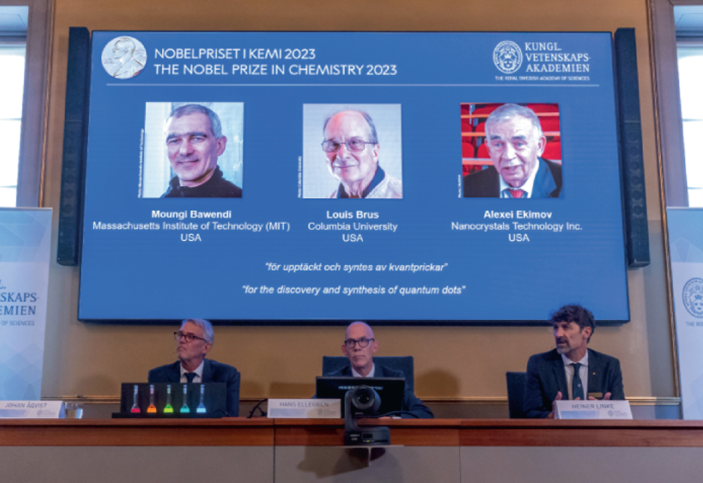This year’s Nobel Prize in Chemistry recognizes a milestone for the entire nanotechnology field.
It went more or less like this on 4 October. In a rather unassuming meeting room we sat with other chemistry editors to follow the announcement of the Royal Swedish Academy of Sciences; cookies provided. The principal candidates for the prize, who had been the subject of much speculation in chemistry magazines and on social media in the days leading up to the event, shaped the sitting pattern: organic chemists in one corner; electrocatalysis enthusiasts in the other; the poor physical chemists somewhat lost in the middle. As 11 am approached, smartphones were refreshed with a frequency rivalling that of an NMR, getting dangerously hot. There were already strong rumours that the prize would be about quantum dots, but that was all forgotten when the Committee, sitting in the press conference room, appeared on the screen. Silence. The techy ones set their translation apps from Swedish to English to counter the tradition of making the announcement first in a language spoken by a trace amount of scientists (but crucially by our Alfred, the one with the money).

Credit: Xinhua / Alamy Stock Photo
Then everything changed. “This year’s prize is about a fundamental discovery in nanotechnology” (https://youtu.be/6ilqb5qlI8s). A sweet music started playing in our ‘nano’-editor brains, our faces smiling like when an experiment works, and then even the Committee on the screen joined in, showing colourful solutions: so beautiful, so fluorescent, like a synaesthetic experience; it was almost too much to take… and we thought those were just cookies!
Only a few minutes later, back from this intense experience, we started realizing the magnitude of what had just happened. A chemistry Nobel Prize to fundamental nanotechnology is not something ordinary. There have been other nanotechnology Nobel Prizes (the C60, graphene, molecular machines, for example), to be sure, but this somehow felt more special. And indeed it is, because it was awarded to the observation of a phenomenon by which matter shows different properties depending on size — a foundational concept for the entire field of nanoscience and nanotechnology, not just for quantum dots. The attraction for nanotechnology stems in part from the fact that it offers relatively simple chemical tools (size, shape, surface chemistry) to control the structure–property relationship of a material in a precise way, something you don’t have in the bulk or in molecules.
We refer you to the Nobel Committee for Chemistry publication1 and to a recent review article2 for a detailed history of the discovery of quantum dots and the role of the awardees: Moungi G. Bawendi, Louis E. Brus and Aleksey Yekimov. In this issue, we are delighted to offer readers a Q&A with Prof. Brus given just a few days after the prize was awarded.
He recalls the early days of his encounter with colloidal quantum dots in the 1982–1986 stretch during his period at Bell Labs, where the observation of a shift over time in the optical absorption peak of cadmium sulfide small crystals crucially captured his scientific interest. In addition, Prof. Brus, now emeritus at Columbia University, offers an important piece of advice to young scientists that is worth re-emphasizing here, because it encapsulates the scientific approach that has made nanotechnology the success that it is. He reflects on the fact that we’re all limited by our scientific background, and that it can sometimes be a ceiling in a scientist’s career because it prevents them from looking at a problem from different points of view. Getting out of the hyper-specialized worlds which scientists often find themselves sucked into requires energy, self-questioning and a good dose of courage. Prof. Brus’s practical advice is to take the time to read papers outside the immediate field of one’s specialization; ask colleagues why they are working on a given problem: what do they find so exciting about it? what drives them?; and always look for a better problem to solve.
As nanoscience and nanotechnology enthusiasts, we know that an interdisciplinary approach to scientific research requires overcoming the initial hurdle of defining, among other things, terminology, investigative tools and expectations. But we also know that bridging that interdisciplinary divide brings value and accelerates discovery, as well as being an enriching experience.
This is why, in addition to being a prize “for the discovery and synthesis of quantum dots”, we interpret the decision of the Swedish Academy as a prize to the whole field of nanoscience and nanotechnology. Maybe that’s why we experienced that moment of numbness and elation at the announcement.
- SEO Powered Content & PR Distribution. Get Amplified Today.
- PlatoData.Network Vertical Generative Ai. Empower Yourself. Access Here.
- PlatoAiStream. Web3 Intelligence. Knowledge Amplified. Access Here.
- PlatoESG. Carbon, CleanTech, Energy, Environment, Solar, Waste Management. Access Here.
- PlatoHealth. Biotech and Clinical Trials Intelligence. Access Here.
- Source: https://www.nature.com/articles/s41565-023-01586-x



